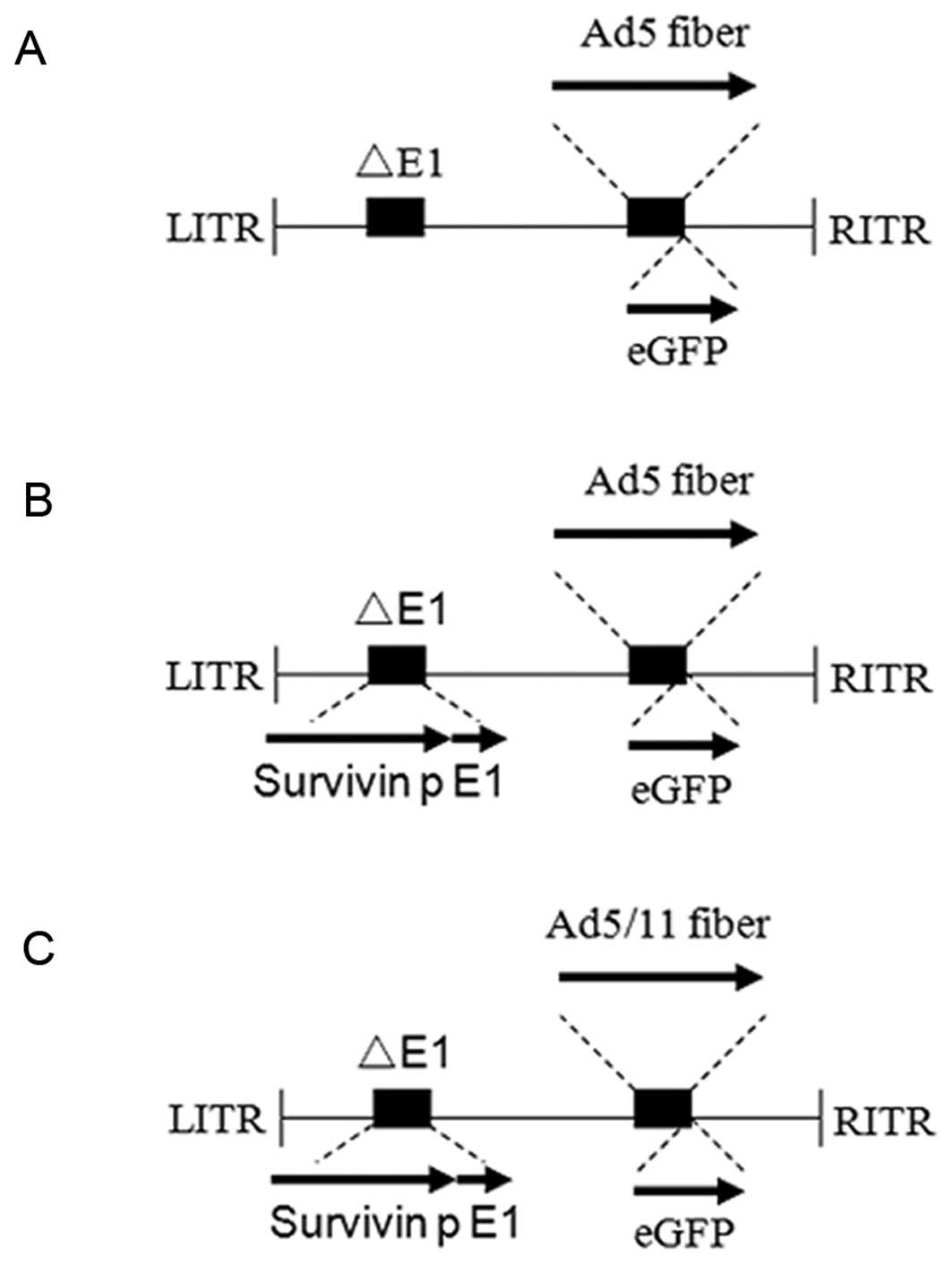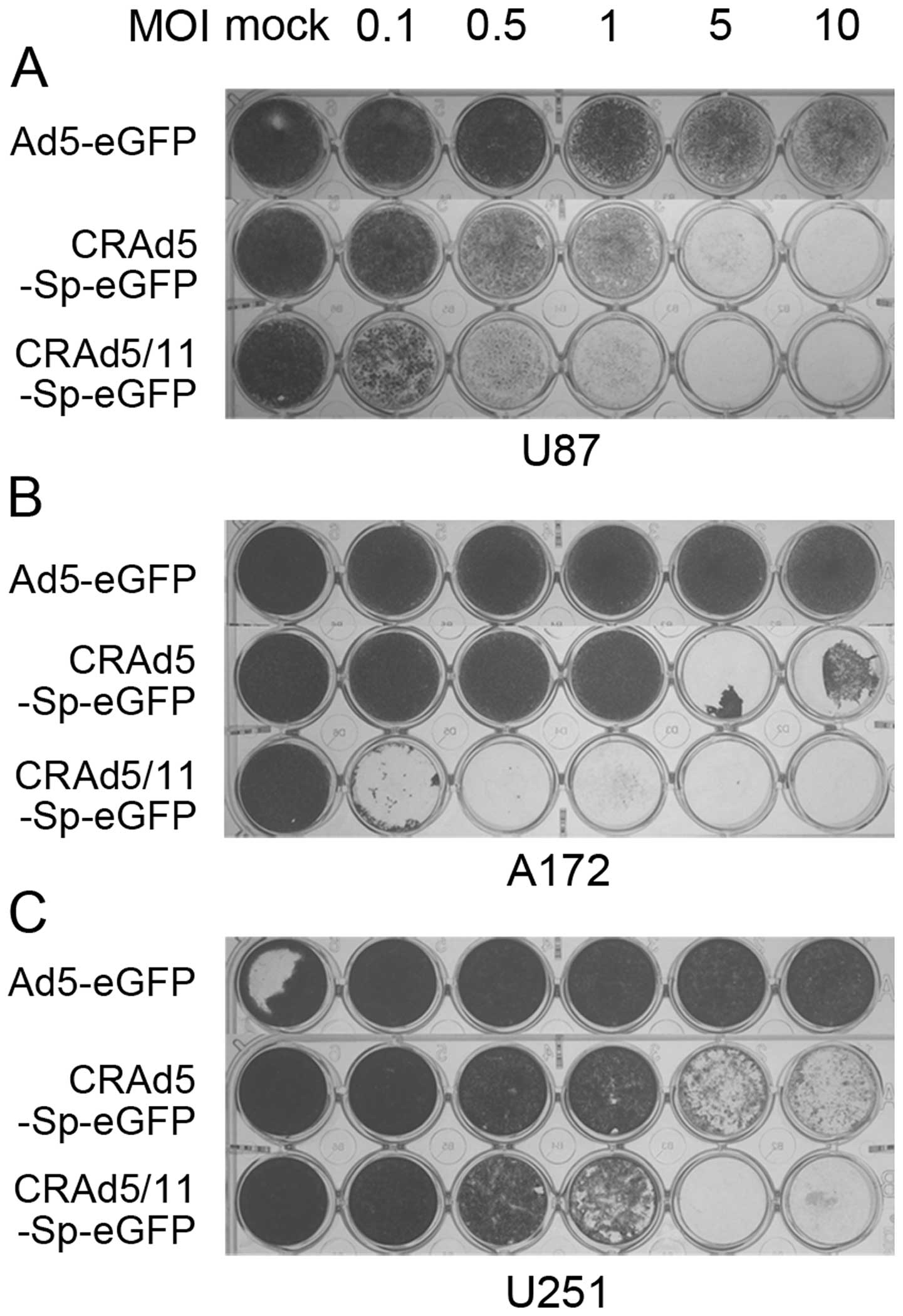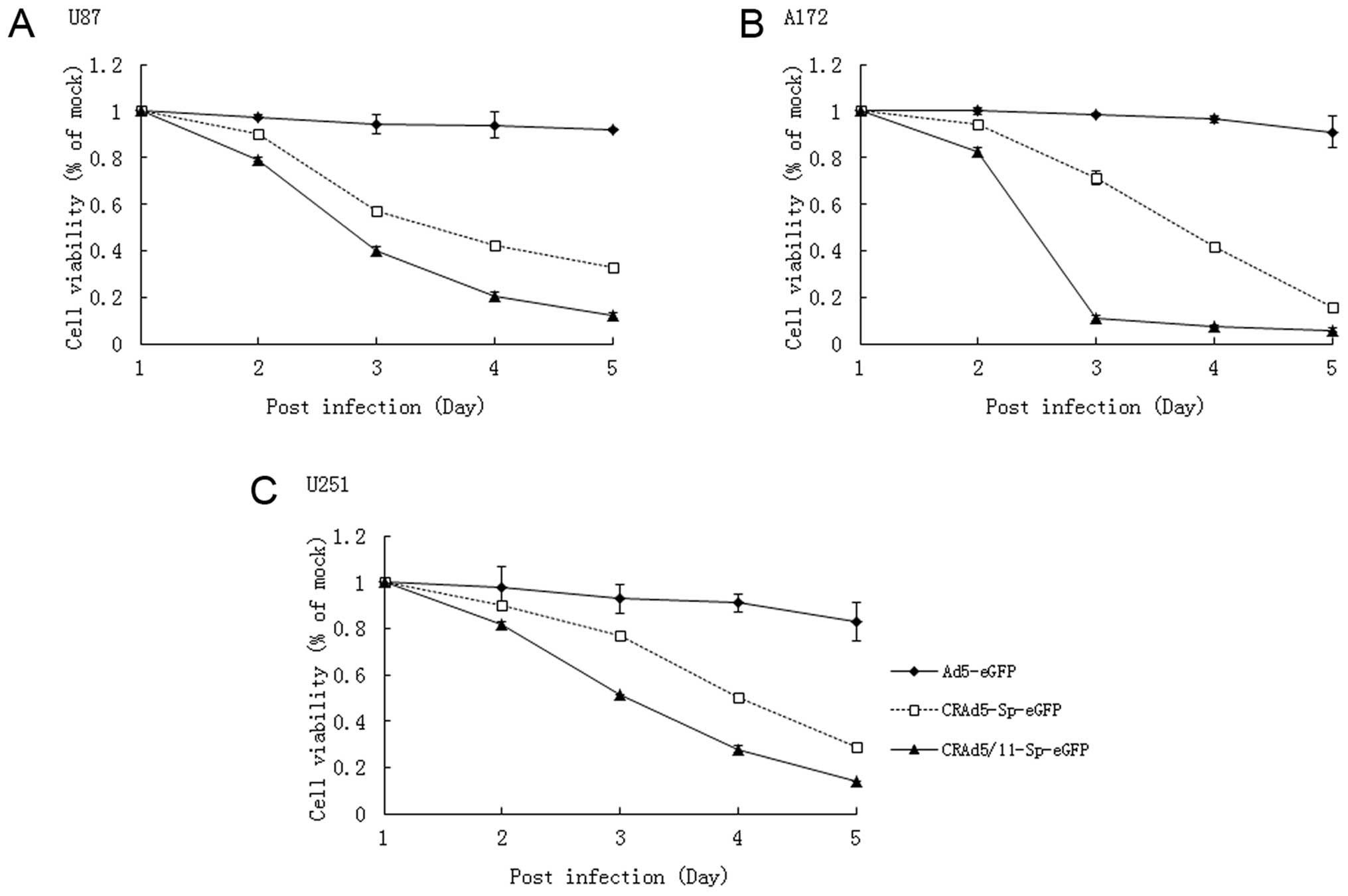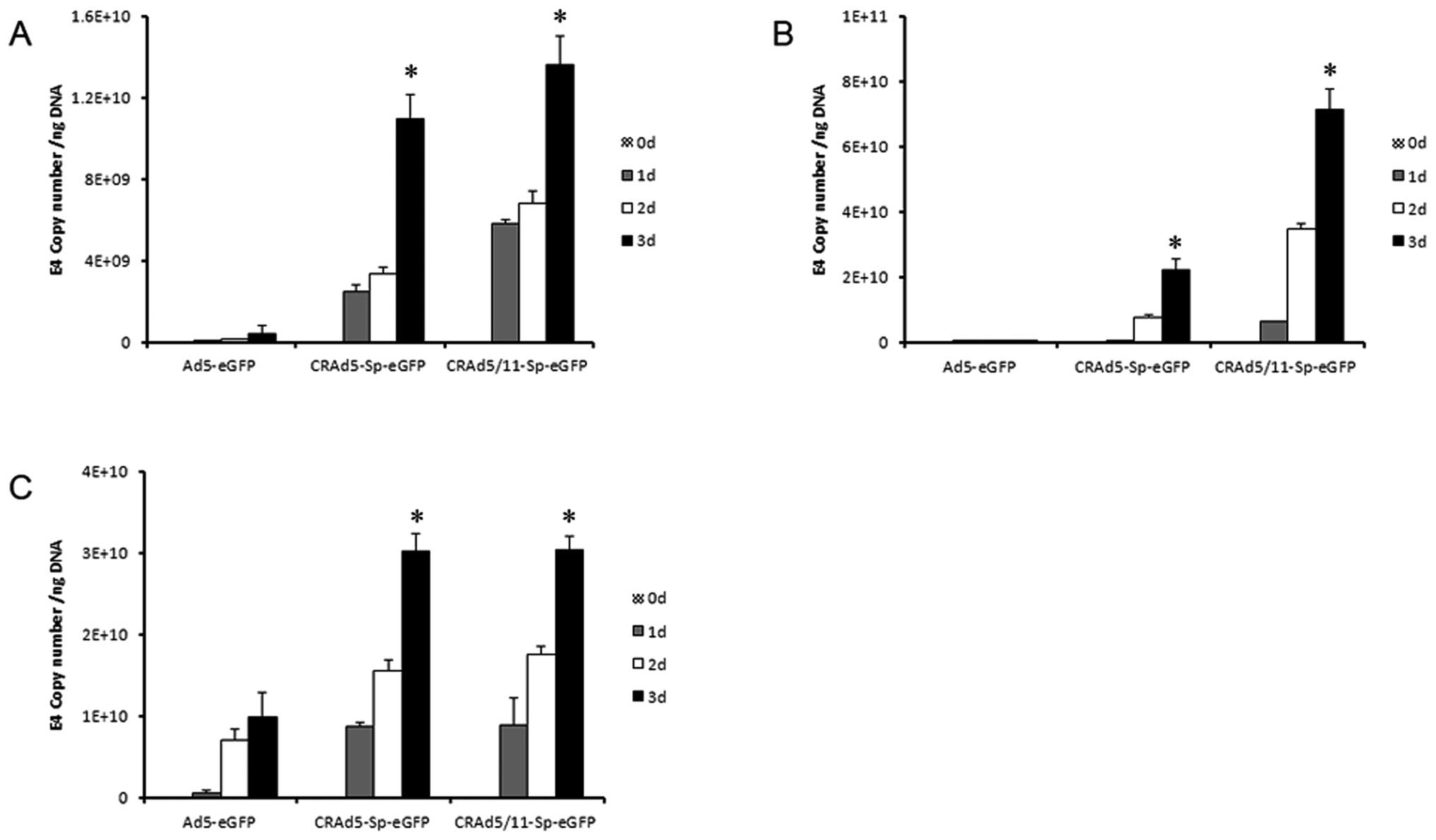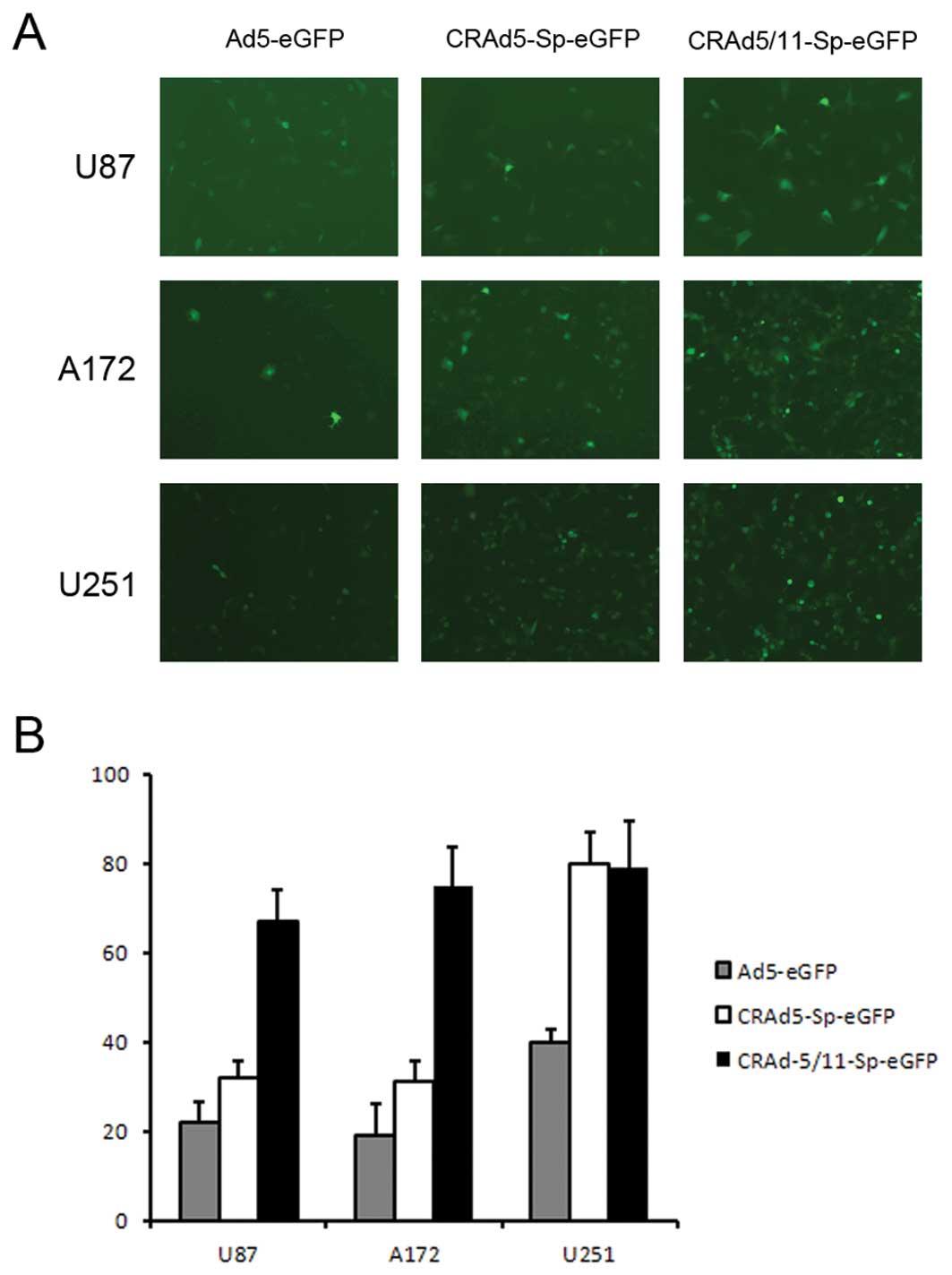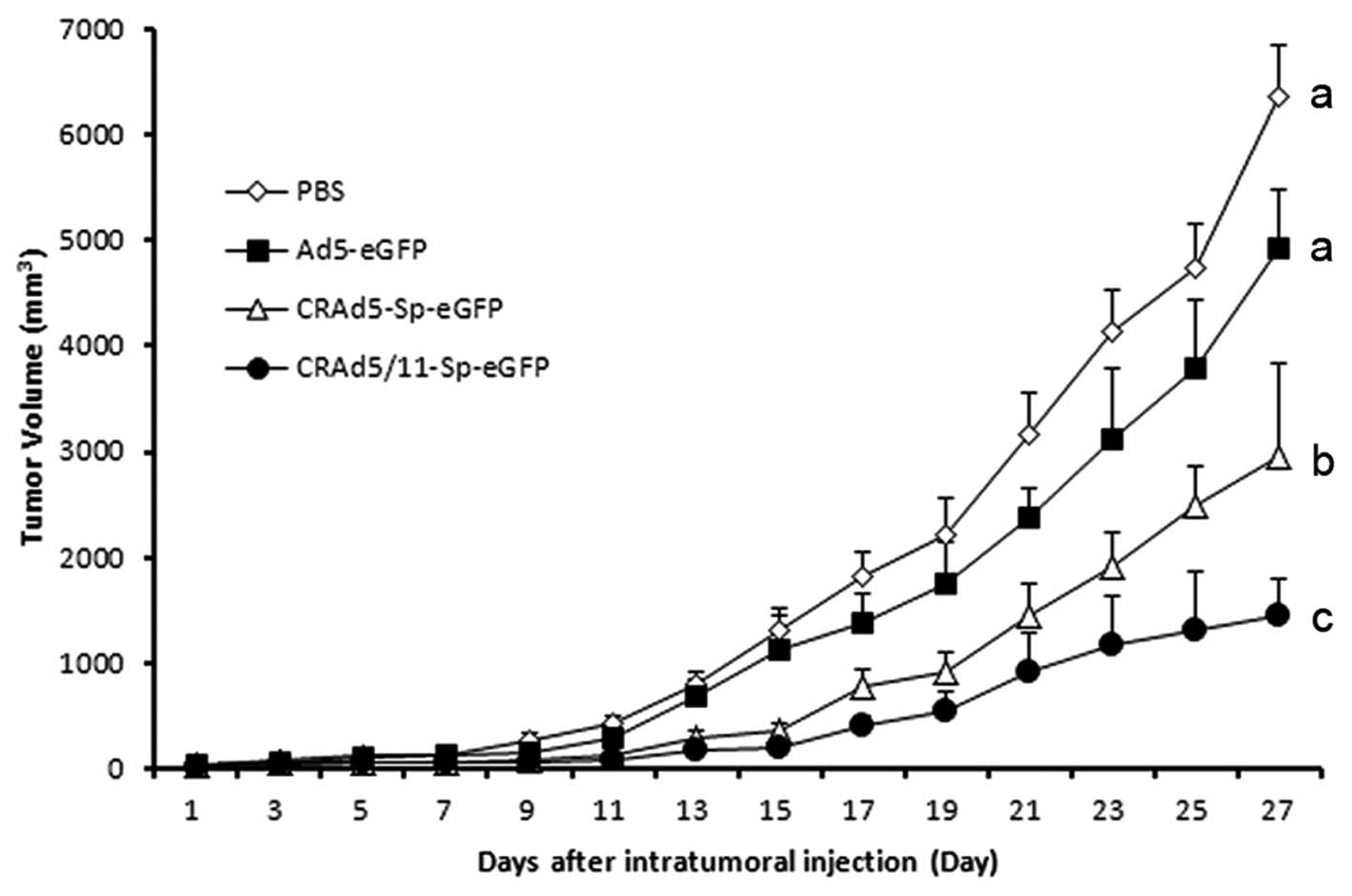A novel Ad5/11 chimeric oncolytic adenovirus for improved glioma therapy
- Authors:
- Published online on: October 18, 2012 https://doi.org/10.3892/ijo.2012.1674
- Pages: 2159-2165
Abstract
Introduction
Glioblastoma multiforme (GBM) is the most common type of brain tumor in adults, exhibiting relentless and malignant progression characterized by widespread invasion throughout the brain, destruction of normal brain tissue, and resistance to surgery, radiotherapy or chemotherapy (1). GBM usually recurs at its original location and within 12 months post-resection (2). Recurrent GBM tumors are usually comprised of tumor cells that are difficult for radiation and/or chemotherapy and do not respond adequately to further treatments. Therefore, the developments of novel agents are urgently needed to enhance their therapeutic effects for GBM tumors.
Because GBM usually relapses around the original site and is localized in the central nervous system (CNS), direct delivery of an oncolytic adenovirus provides the potential to effectively target these tumors (3). Conditionally replicating adenovirus (CRAd) propagates in tumor cells but not in normal cells, which represents a novel approach for cancer treatment. Recent preclinical research suggested the potential efficacy of these viruses, and clinical studies confirmed the safety profile of these agents (4–7). However, the numbers of cancer gene therapy clinical trials performed to date had fallen short with respect to initial expectations of demonstrable therapeutic outcome. A major limitation of these vectors has been the poor replication and weak transduction in neighboring tumor cells. A better viral vector can be achieved by the application of tumor-specific promoters (TSP) to improve tumor-specific replication of the vector and by the modifications of viral capsids to enhance viral transduction.
One of the approaches to improve the replicative specificity of CRAd is based on the tissue- or tumor-specific transcriptional control of the essential early genes required for viral replication. For CRAd, the adenovirus genome is usually genetically modified to replace the E1A promoter region with the desired tissue- or tumor-specific expression profile. The ideal tumor specific promoter (TSP) would display an alternatively ‘tumor on/normal tissue off’ expression profiles. To develop TSP-based CRAd, one of the commonly used methods is to drive E1 gene expression with a selected promoter. Survivin, a member of the inhibitor of apoptosis protein (IAP) family, is highly expressed in most human tumors and fetal tissues, but rarely detectable in terminally differentiated cells (8). Eighty percent of GBM tumors demonstrate abundant survivin expression (9), and a clear correlation is seen between the histological grade of a glioma and the fraction of survivin-positive tumor cells (10). Previous studies showed that the adenoviral E1A driven by the human survivin promoter was responsible for the enhanced viral replication and improved oncolytic ability in malignant gliomas (10,11). Therefore, this promoter is a promising candidate to drive E1 expression in the development of a new CRAd agent.
The wild-type human adenovirus (Ad5) has demonstrated relatively poor transduction efficiency in malignant glioma cells because of the low-level expression of the Coxsackievirus and adenovirus receptor (CAR) on the tumor cells (12). To circumvent this issue, the adenovirus fiber protein could be modified by genetic method for improving the transduction of adenoviral vector in CAR-deficient cells. One of the approaches is the substitution of the knob domain of Ad5 with knobs from alternate Ad serotypes, for example, species B (13). Human species B adenoviruses can utilize ubiquitously expressed CD46 as a receptor for entry into host cells (14–16). Ad11, which belongs to adenovirus species B, was reported to possess strong ability to bind and infect human CD46 positive cells (17,18).
Up to now, modified oncolytic adenoviral vectors have used different methods including introduction of tumor/tissue-specific promoters, hexon or fiber modification. In this study, we hypothesized that transcriptional and transductional control of viral replication would enhance the oncolytic effect of virus against malignant gliomas. To test this hypothesis, we for the first time constructed chimeric oncolytic adenoviral vector CRAd5/11-Sp-eGFP by combinationally using a survivin-driven and chimeric 5/11 fiber and examined the targeting and oncolytic efficacy of CRAd5/11-Sp-eGFP in vitro and in vivo. This novel vector CRAd5/11-Sp-eGFP was found to exhibit enhanced antitumor activity compared with the wild-type fiber.
Materials and methods
Cells and culture conditions
Human malignant glioma cell lines U87, A172, U251 and human embryonic kidney cell line HEK-293 were purchased from American Type Culture Collection (ATCC, Manassas, VA, USA). All cell lines were cultured in Dulbecco’s modified Eagle’s medium (DMEM) supplemented with 10% heat-inactivated fetal calf serum, 100 U/ml penicillin, 100 μg/ml streptomycin, and L-glutamine (200 μg/ml) and incubated in a humidified 37°C atmosphere of 95% air and 5% CO2.
Construction of recombinant adenovirus
CRAd5/11-Sp-eGFP was constructed as follows: i) The generation of the shuttle vector pAd5-E1-Sp which the E1 gene was under the control of survivin promoter. The survivin promoter fragment corresponding to the region from nt2532 to nt2764 in the DNA sequence (GenBank Access no: U75285) was amplified from human genomic DNA by PCR using forward primer, 5′-AGGATCCGCACGCGTTCTTTGAAAGC-3′, and reverse primer, 5′-TAAGCTTCCACCTCTGCCAACGGGTC-3′ (19). The amplified survivin promoter was subcloned into the plasmid pshuttle-Ad5-E1 by BamHI and HindIII restriction sites. A SV40 poly-A (PA) fragment was then cut with XbaI/BamHI from a pGL3B vector (Invitrogen, Carlsbad, CA, USA) and inserted into the pshuttle-Ad5-E1 by use of the same restriction sites. The resultant plasmid was named pAd5-E1-Sp. ii) The construction of pCRAd5-Sp, which was achieved by co-transforming ScaI linearized pAd5-E1-Sp and ClaI digested pTG3602/SwaI into E. coli BJ5183 (20). iii) The construction of shuttle plasmid pBS/Ad5/11-eGFP which includes the chimeric fiber Ad5/11 and eGFP. First, we synthesized a gene which includes Ad5 tail (522–608 bp), Ad11 shaft and knob sequence in pcDNA 3.1(+) (Sangon, Shanghai, China). The plasmid was named pcDNA 3.1(+)/Ad5/11 which included a unique NdeI and SpeI restriction introduced separately in its 5′ and 3′ end. The pcDNA 3.1(+)/Ad5/11 digested by NdeI and SpeI was ligated with an NdeI/SpeI-linearized pBS shuttle vector at 4:1 (v/v) ratio (20). The positive clones were screened by enzyme digestion and DNA sequencing and named pBS/Ad5/11. Second, we constructed an expression cassette that the CMV promotes eGFP expression. This cassette digested by BamHI and SfuI was inserted into the region between E4 and the fiber located in the pBS/Ad5/11 to acquire the shuttle vector pBS/Ad5/11-eGFP. iv) For the generation of CRAd5/11-Sp-eGFP vector, the pCRAd5-Sp digested with SwaI and the pBS/Ad5/11-eGFP digested with XhoI was co-transformed into E. coli BJ5183 cells. The resulting plasmid was designated pCRAd5/11-Sp-eGFP. PacI linearized pCRAd5/11-Sp-eGFP was transfected into HEK-293 cells. Then recombinant adenovirus CRAd5/11-Sp-eGFP was propagated in HEK-293 cells and purified by cesium chloride gradient methods. The titers were detected by spectrophotometry at an absorbance (A) of 260 nm. Using similar strategy, the recombinant adenoviruses CRAd5-Sp-eGFP was produced.
Viral oncolytic potency in human glioma cells
For determination of virus-mediated cell killing ability, 5×104 glioma cells (U87, A172 and U251) were seeded in 24-well plates and infected with adenoviruses at various multiplicity of infection (MOI) or phosphate-buffered saline (PBS) for 4 h followed by replacement of infection media with growth media. Seven days after infection, in order to visualize cell killing, cells were fixed and stained with 2% crystal violet in 70% ethanol for 20 min followed by washing with distilled water to remove excess dye. The plates were dried and images were captured with an Alpha Innotech FluroChem (Santa Clara, CA, USA).
Cell viability assay
U87, A172 and U251 were cultured in 96-well plates at 5×103 cells per well. Twenty-four hours later, viruses at 5 MOI were administered into cells. The plates were incubated at 37°C and supplemented with 5% CO2. PBS was used as a control. The medium was removed every 24 h and fresh medium containing 20 μl of 3-(4,5-dimethythiazol-2-yl)-2,5-diphenyltetrazolium bromide (MTT; 1 μg/ml) solution was added to each well. Four hours later, MTT was discarded and 150 μl of DMSO was loaded. The spectrophotometric absorbance of the samples was measured with a Multiskan MK3 (Thermo Electron Corporation, Waltham, MA, USA) at 570 nm. The percentage of cell viability was calculated using the following formula: cell viability = absorbance value of infected cells/absorbance value of uninfected control cells. Six duplicate wells were measured and the experiments were done at least three times.
Quantitative real-time PCR for the Ad5 E4 gene
U87, A172 and U251 cells were seeded in 6-well plates (5×105 cell/well) and infected with Ad5-eGFP, CRAd5-Sp-eGFP and CRAd5/11-Sp-eGFP at a MOI of 5. At each 24 h post-infection, the cells were washed with PBS and harvested. The DNA was then purified with a TIANamp blood DNA kit (Tiangen, China). Quantitative polymerase chain reaction (PCR) was performed with primers (Ad5 E4 for, 5′-CATGCGCCGCTGCCCTGATA-3′; and Ad5 E4 reverse, 5′-TTCCCGCTCCTCCCGTGTGT-3′) against a 99 base pair region of the E4 gene. The amplified Glyceraldehyde-3-phosphate dehydrogenase (GAPDH) based on specific primers (GAPDH for, 5′-TGGTGAAGACGCCAGTGGA-3′; and GAPDH reverse, 5′-GCACCGTCAAGGCTGAGAAC-3′) was used for an internal control. All reactions, performed in triplicate in a total reaction volume of 20 μl, using SYBR Premix Ex Taq™ II (Takara, Japan), were carried out in a Bio-Rad iQ5 instrument (Bio-Rad, Hercules, CA, USA). The parameters were used for amplification and melting curve analysis was described by Li et al (21). For quantitative analysis, viral genomes were purified from each group using the same quantity of viral particles (assessed by spectrophotometrically) and serially diluted to generate a standard curve.
Adenovirus transduction analysis
U87, A172 and U251 cells were plated at a density of 5×105/well in a 60-mm dish culture plate for 24 h prior to infection, then Ad5-eGFP, CRAd5-Sp-eGFP and CRAd5/11-Sp-eGFP were applied to the U87, A172 and U251 cells at the dosage of 500 viral particle/cell. For quantification of eGFP expression level, photographs were taken at 24 h post-infection with 10 × objective (3-sec exposure time). The infection efficiency was quantified by counting eGFP-positive cells.
Studies of xenograft tumors in nude mice
U87 tumor xenografts were established by subcutaneously inoculating 2×106 cells into the right flanks of 4- to 6-week-old female BALB/c nude mice (Animal Research Committee of the Institute of Biochemistry and Cell Biology, Shanghai, China). When tumors reached between 70 to 100 mm3, 28 mice were randomly assigned to PBS treated group, Ad5-eGFP treated group, CRAd5-Sp-eGFP treated group and CRAd5/11-Sp-eGFP treated group, respectively. The established tumors were injected with 50 μl of PBS or 5×108 plaque-forming units (PFU) of virus. The injections were repeated four times, every other day. Tumor growth was monitored by periodic measurements with calipers and tumor volume was calculated using the following formula: tumor volume (mm3) = length (mm) × width2 (mm2)/2. The tumor volumes of the 7 mice in each group were measured every 2 days for 1 month.
Statistical analysis
Statistical analysis for all experimental conditions was performed using the Statistical Package for the Social Sciences (SPSS) software (version 13, Chicago, IL, USA). The difference between each control and experimental groups was analyzed by using one-way analysis of variance between groups (ANOVA/LSD). In all cases, a p-value <0.05 was considered statistically significant.
Results
Chimeric fiber 5/11 modified oncolytic adenovirus CRAd5/11-Sp-eGFP for improved cell killing ability in glioma cells in vitro
In order to assay biological activity of the oncolytic adenoviruses (Fig. 1), glioma cell lines of U87, A172 and U251 were infected with CRAd5-Sp-eGFP, CRAd5/11-Sp-eGFP or replication-deficient Ad5-eGFP virus at the dose of 0, 0.1, 0.5, 1, 5 and 10 MOI, respectively. Cell killing effect was then assessed via crystal violet staining. Of the tested vectors, CRAd5/11-Sp-eGFP demonstrated a dose-dependent cell killing effect in all the human glioma cell lines (Fig. 2) with a dose as low as 0.1 MOI in A172 cells and at 1 MOI in U87 and U251 cells. Of note, the oncolytic effect of CRAd5/11-Sp-eGFP was about 100 times superior to that of CRAd5-Sp-eGFP in the A172 cell lines. Less or no cell killing effect was observed with the control, the replication-defective Ad5-eGFP vector. Cell viability was quantified by MTT assay. Tumor cell lines (U87, A172 and U251) were infected with CRAd5-Sp-eGFP, CRAd5/11-Sp-eGFP or replication-deficient adenovirus Ad5-eGFP at MOI of 5. As shown in Fig. 3, CRAd5-Sp-eGFP and CRAd5/11-Sp-eGFP was able to inhibit growth of glioma cells in a time-dependent manner. In addition, CRAd5/11-Sp-eGFP significantly inhibited the growth of all three tumor cell lines compared with CRAd5-Sp-eGFP. The results indicated that the fiber chimeric oncolytic virus constructed by us significantly enhanced cell killing effect against glioma cells compared with fiber unmodified oncolytic adenovirus.
Efficient replication of chimeric fiber 5/11 modified CRAd in glioma cells
Efficient viral replication can greatly contribute to the antitumor capacity of CRAd. Here, in order to investigate the replicative ability of the modified CRAds in glioma cell, U87, A172 and U251 cells were infected at 5 MOI of Ad5-eGFP, CRAd5-Sp-eGFP and CRAd5/11-Sp-eGFP and harvested in triplicate at 0, 1, 2 and 3 days after infection. Total DNA was isolated from the cells and viral replication was measured by qPCR using primers for the Ad5 E4 gene. As seen in Fig. 4, CRAd5-Sp-eGFP and CRAd5/11-Sp-eGFP all demonstrated significantly enhanced replication of viral genome compared with Ad5-eGFP (p<0.001). This result indicated that U87, A172 and U251 cells maintained high level of survivin promoter activity, which therefore resulted in specific replication of CRAd5-Sp-eGFP and CRAd5/11-Sp-eGFP in these three glioma cell lines. The result also suggested that the eGFP expression cassette located between the fiber and E4 region did not influence the replication capacity.
Enhanced transduction efficiency of fiber modified adenovirus in target cells
To confirm that the improved cytotoxic effect of Ad5/11 fiber chimeric CRAd in glioma cells, the transduction efficiency of the chimeric fiber adenovirus was evaluated. Ad5-eGFP, CRAd5-Sp-eGFP and CRAd5/11-Sp-eGFP were applied to U87, A172 and U251 cells that express a high level of CD46, the receptor of Ad11. The results showed that the percentage of eGFP positive cells in CRAd5/11-Sp-eGFP group was higher than that in the control groups Ad5-eGFP and CRAd5-Sp-eGFP in U87 and A172 cells (Fig. 5). This indicated that the tropism efficiently enhanced U87 and A172 target cells and it was mainly attributed to the modified fiber.
CRAd5/11-Sp-eGFP for improved antitumor activity in nude mice
In order to evaluate antitumor activity of CRAd5/11-Sp-eGFP in vivo, U87 human glioma xenograft model was established in nude mice. When the tumors reached 70-100 mm3, 50 μl of Ad5-eGFP, CRAd5-Sp-eGFP, CRAd5/11-Sp-eGFP (5×108 PFU each) or PBS as the control was injected intratumorally every other day four times. The results indicated that animals treated with CRAd5/11-Sp-eGFP exhibited significant suppression of tumor growth compared with those treated with PBS (p<0.05) or Ad5-eGFP (p<0.05).
The average tumor volume of the CRAd5/11-Sp-eGFP group was about 1,400 mm3 at 29 days after virus treatment, whereas the tumor volume of PBS- or Ad5-eGFP-treated mice was 6,351±496.8 or 4,933.4±542.6 mm3, respectively. In addition, the CRAd5-Sp-eGFP-treated group showed notable antitumor efficacy compared with the PBS- or Ad5-eGFP-treated group (p<0.05) (Fig. 6). These data indicated that survivin-driven fiber chimeric oncolytic adenovirus, CRAd5/11-Sp-eGFP exerted strong antitumor activity.
Discussion
In the present study, we constructed a survivin-driven, chimeric 5/11 fiber-modified conditionally replicating adenovirus, CRAd5/11-Sp-eGFP. In previous studies, the exogenous gene expression cassettes usually were located in the E1 region or E3 region (22–26). In this study, the exogenous gene expression cassette was inserted into the region between E4 and the fiber by using a novel shuttle vector which contained the modified fiber and an expression cassette. This method provided us a new option for expressing an exogenous gene in oncolytic adenovirus except for conventional E1 or E3 region. In addition, the modification of the fiber protein and the insertion of an exogenous gene expression cassette into the region between the fiber and E4 could be conveniently done via one step homologous recombination by using the novel shuttle vector. The results showed that this novel oncolytic adenoviral vector exhibited enhanced tumor targeting and antiglioma activity both in vitro and in vivo.
The replicative specificity of CRAd is based on tumor-specific transcriptional control of the essential early genes required for replication. The ideal tumor specific promoter (TSP) would exhibit accurate expression profiles in the specific cancer tissue. Survivin is an important member of the IAP family that serves a dual role in the inhibition of apoptosis and regulation of cell division. One of the most important features of survivin is the differential expression of this protein in cancer versus normal tissue. Dramatic overexpression of survivin has been demonstrated in brain tumor, including malignant glioma (27,28). Zhu et al showed that the survivin promoter is upregulated in brain tumors (27). Moreover, a study from Van Houdt et al demonstrated that survivin promoter-based CRAd could be efficiently replicated within and kill a variety of established glioma tumor cells and significantly inhibit the growth of glioma xenografts in vivo (10). Similarly, in our study the CRAd that uses the survivin promoter revealed improved replication activity and oncolytic effect in glioma cells compared with the controls.
CRAd-mediated gene therapy in the context of malignant brain tumors is hindered by lack of a sufficient number of Ad receptors or CAR, on the glioma cell surface (29). Fiber chimeric adenovirus vectors from species B adenovirus have been reported (3,13,30,31), but 5/11 fiber with a replication-competent vector to improve virus transduction in gliomas has not been identified. There is a lack of 5/11 chimeric fiber adenovirus vector that have the high replication efficiency in gliomas and still carry a quantifiable marker gene. A precise evaluation of the oncolytic vectors with 5/11 chimeric fiber in different glioma cells remains to be addressed. In this study, the viral entry into glioma cells is significantly enhanced when the Ad5 fiber knob is replaced with the Ad11 knob, the latter of which recognizes the CD46 receptor that is widely expressed on tumor cells including gliomas (13,18). In addition, the Ad11 belongs to species B group 3 which preferentially interacts with CD46, but also uses receptor desmoglein 2 (32). The Ad3 shares the receptor desmoglein 2 with Ad11 and Ad35 nearly exclusively uses CD46 as its receptor. Thus, we hypothesis Ad11 have a more wide-range to target tumor cells and the results need further study. In the present study, we have shown that the virus of CRAd5/11-Sp-eGFP efficiently infected the U87 and A172 cell lines, as demonstrated by fluorescent microscopy. Therefore, infection of CRAd5/11-Sp-eGFP significantly inhibited U87 and A172 cell growth. Nevertheless, in U251 cell, the adenovirus of CRAd5-Sp-eGFP and CRAd5/11-Sp-eGFP had little difference in transduction efficiency. Allen et al reported U251 expresses the high level of CAR compared with other gliomas, such as U87, U118 and TE671 (33). Mäenpää et al found that U251 was moderately positive for CD46 expression (34). These results illustrated that CRAd5-Sp-eGFP and CRAd5/11-Sp-eGFP possessed the same level of eGFP-positive cells.
Compared with CRAd5-Sp-eGFP in vitro, CRAd5/11-Sp-eGFP exhibited higher infection efficiency and stronger oncolytic ability in glioma cells, and enhanced antitumor efficacy in human glioma U87 xenograft models. In summary, survivin-driven and chimeric 5/11 fiber-modified CRAds vector CRAd5/11-Sp-eGFP is a promising candidate in the treatment of malignant glioma.
Acknowledgements
This study was supported by the research grants to H.X. from National Natural Science Foundation of China (no. 30872993 and no. 31070137).
References
|
Furnari FB, Fenton T, Bachoo RM, et al: Malignant astrocytic glioma: genetics, biology, and paths to treatment. Genes Dev. 21:2683–2710. 2007. View Article : Google Scholar : PubMed/NCBI | |
|
Grossman SA, Ye X, Piantadosi S, et al: Survival of patients with newly diagnosed glioblastoma treated with radiation and temozolomide in research studies in the United States. Clin Cancer Res. 16:2443–2449. 2010. View Article : Google Scholar : PubMed/NCBI | |
|
Ulasov IV, Zhu ZB, Tyler MA, et al: Survivin-driven and fiber-modified oncolytic adenovirus exhibits potent antitumor activity in established intracranial glioma. Hum Gene Ther. 18:589–602. 2007. View Article : Google Scholar | |
|
Chiocca EA, Abbed KM, Tatter S, et al: A phase I open label, dose-escalation, multi-institutional trial of injection with an E1B-attenuated adenovirus, ONYX-015, into the peritumoral region of recurrent malignant gliomas, in the adjuvant setting. Mol Ther. 10:958–966. 2004. View Article : Google Scholar | |
|
Yazaki T, Manz HJ, Rabkin SD and Martuza EL: Treatment of human malignant meningiomas by G207, a replication-competent multimutated herpes simplex virus 1. Cancer Res. 55:4752–4756. 1995.PubMed/NCBI | |
|
Markert JM, Medlock MD, Rabkin SD, et al: Conditionally replicating herpes simplex virus mutant, G207 for the treatment of malignant glioma: results of a phase I trial. Gene Ther. 7:867–874. 2000. View Article : Google Scholar : PubMed/NCBI | |
|
Sonabend AM, Ulasov IV and Lesniak MS: Gene therapy trials for the treatment of high-grade gliomas. Gene Ther Mol Biol. 11:79–92. 2007.PubMed/NCBI | |
|
Sah NK, Khan Z, Khan GJ and Bisen PS: Structural, functional and therapeutic biology of survivin. Cancer Lett. 244:164–171. 2006. View Article : Google Scholar : PubMed/NCBI | |
|
Chakravarti A, Noll E, Black PM, Finkelstein DF, Finkelstein DM, Dyson NJ and Loeffler JS: Quantitatively determined survivin expression levels are of prognostic value in human gliomas. J Clin Oncol. 20:1063–1068. 2002. View Article : Google Scholar : PubMed/NCBI | |
|
Van Houdt WJ, Haviv YS, Lu B, et al: The human survivin promoter: a novel transcriptional targeting strategy for treatment of glioma. J Neurosurg. 104:583–592. 2006.PubMed/NCBI | |
|
Ulasov IV, Rivera AA, Sonabend AM, Rivera LB, Wang M, Zhu ZB and Lesniak MS: Comparative evaluation of survivin, midkine, and CXCR4 promoters for transcriptional targeting of glioma gene therapy. Cancer Biol Ther. 6:679–685. 2007. View Article : Google Scholar : PubMed/NCBI | |
|
Asaoka K, Tada M, Sawamura Y, Ikeda J and Abe H: Dependence of efficient adenoviral gene delivery in malignant glioma cells on the expression levels of the Coxsackievirus and adenovirus receptor. J Neurosurg. 92:1002–1008. 2000. View Article : Google Scholar : PubMed/NCBI | |
|
Nandi S, Ulasov IV, Rolle CE, Han Y and Lesniak MS: A chimeric adenovirus with an Ad 3 fiber knob modification augments glioma virotherapy. J Gene Med. 11:1005–1011. 2009. View Article : Google Scholar : PubMed/NCBI | |
|
Segerman A, Atkinson JP, Marttila M, Dennerquist V, Wadell G and Arnberg N: Adenovirus type 11 uses CD46 as a cellular receptor. J Virol. 77:9183–9191. 2003. View Article : Google Scholar : PubMed/NCBI | |
|
Gaggar A, Shayakhmetov DM and Lieber A: CD46 is a cellular receptor for group B adenoviruses. Nat Med. 9:1408–1412. 2003. View Article : Google Scholar : PubMed/NCBI | |
|
Sirena D, Lilienfeld B, Eisenhut M, et al: The human membrane cofactor CD46 is a receptor for species B adenovirus serotype 3. J Virol. 78:4454–4462. 2004. View Article : Google Scholar : PubMed/NCBI | |
|
Fleischli C, Sirena D, Lesage G, Havenga MJ, Cattaneo R, Greber UF and Hemmi S: Species B adenovirus serotypes 3, 7, 11 and 35 share similar binding sites on the membrane cofactor protein CD46 receptor. J Gen Virol. 88:2925–2934. 2007. View Article : Google Scholar : PubMed/NCBI | |
|
Gustafsson DJ, Andersson EK, Hu YL, Marttila M, Lindman K and Strand M: Adenovirus 11p downregulates CD46 early in infection. Virology. 405:474–482. 2010. View Article : Google Scholar : PubMed/NCBI | |
|
Zhu ZB, Makhija SK, Lu B, et al: Incorporating the survivin promoter in an infectivity enhanced CRAd-analysis of oncolysis and antitumor effects in vitro and in vivo. Int J Oncol. 27:237–246. 2005.PubMed/NCBI | |
|
Xia H, Anderson B, Mao Q and Davidson BL: Recombinant human adenovirus: targeting to the human transferrin receptor improves gene transfer to brain microcapillary endothelium. J Virol. 74:11359–11366. 2000. View Article : Google Scholar : PubMed/NCBI | |
|
Li X, Liu S, Wang D, Chen H and Xia H: Adenoviral delivered eGFP-intron splicing system for multiple gene RNAi. Biotechnol Lett. 33:1723–1728. 2011. View Article : Google Scholar : PubMed/NCBI | |
|
Zhang KJ, Wang YG, Cao X, et al: Potent antitumor effect of interleukin-24 gene in the survivin promoter and retinoblastoma double-regulated oncolytic adenovirus. Hum Gene Ther. 20:818–830. 2009. View Article : Google Scholar : PubMed/NCBI | |
|
Chen W, Wu Y, Liu W, et al: Enhanced antitumor efficacy of a novel fiber chimeric oncolytic adenovirus expressing p53 on hepatocellular carcinoma. Cancer Lett. 307:93–103. 2011. View Article : Google Scholar : PubMed/NCBI | |
|
Xiao LL, Wu YM, Qian J, et al: The antitumor efficacy of IL-24 mediated by E1A and E1B triple regulated oncolytic adenovirus. Cancer Biol Ther. 10:242–250. 2010. View Article : Google Scholar : PubMed/NCBI | |
|
Bortolanza S, Bunuales M, Otano I, et al: Treatment of pancreatic cancer with an oncolytic adenovirus expressing interleukin-12 in Syrian hamsters. Mol Ther. 17:614–622. 2009. View Article : Google Scholar : PubMed/NCBI | |
|
Wohlfahrt ME, Beard BC, Lieber A and Kiem HP: A capsid-modified, conditionally replicating oncolytic adenovirus vector expressing TRAIL leads to enhanced cancer cell killing in human glioblastoma models. Cancer Res. 67:8783–8790. 2007. View Article : Google Scholar | |
|
Zhu ZB, Makhija SK, Lu B, et al: Transcriptional targeting of tumors with a novel tumor-specific survivin promoter. Cancer Gene Ther. 11:256–262. 2004. View Article : Google Scholar : PubMed/NCBI | |
|
Ulasov IV, Tyler MA, Zhu ZB, Han Y, He TC and Lesniak MS: Oncolytic adenoviral vectors which employ the survivin promoter induce glioma oncolysis via a process of beclin-dependent autophagy. Int J Oncol. 34:729–742. 2009.PubMed/NCBI | |
|
Fuxe J, Liu L, Malin S, Philipson L, Collins VP and Pettersson RF: Expression of the coxsackie and adenovirus receptor in human astrocytic tumors and xenografts. Int J Cancer. 103:723–729. 2003. View Article : Google Scholar : PubMed/NCBI | |
|
Silver J and Mei YF: Transduction and oncolytic profile of a potent replication-competent adenovirus 11p vector (RCAd11pGFP) in colon carcinoma cells. Plos One. 6:e175322011. View Article : Google Scholar : PubMed/NCBI | |
|
Brouwer E, Havenga MJ, Ophorst O, et al: Human adenovirus type 35 vector for gene therapy of brain cancer: improved transduction and bypass of pre-existing anti-vector immunity in cancer patients. Cancer Gene Ther. 14:211–219. 2007. View Article : Google Scholar : PubMed/NCBI | |
|
Wang H, Li ZY, Liu Y, et al: Desmoglein 2 is a receptor for adenovirus serotypes 3, 7, 11 and 14. Nat Med. 17:96–104. 2011. View Article : Google Scholar : PubMed/NCBI | |
|
Allen C, McDonald C, Giannini C, Peng KW, Rosales G, Russell SJ and Galanis E: Adenoviral vectors expressing fusogenic membrane glycoproteins activated via matrix metalloproteinase cleavable linkers have significant antitumor potential in the gene therapy of gliomas. J Gene Med. 6:1216–1227. 2004. View Article : Google Scholar | |
|
Mäenpää A, Junnikkala S, Hakulinen J, Timonen T and Meri S: Expression of complement membrane regulators membrane cofactor protein (CD46), decay accelerating factor (CD55), and protectin (CD59) in human malignant gliomas. Am J Pathol. 148:1139–1152. 1996. |



